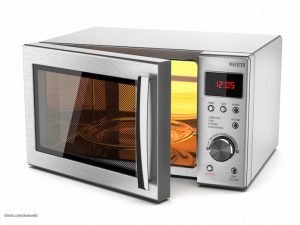There are two issues that may have had an effect on the Farm Rich E. coli 0121 outbreak that has sickened 27 people in 15 states. Two patients in that outbreak have developed hemolytic uremic syndrome (HUS), a complication of STEC bacterial infections that can cause kidney failure. One issue is label confusion; the other is microwave safety. It’s an unfortunate fact of modern life that processed foods can be contaminated with pathogenic bacteria and there is no way for the consumer to know if that processed food is safe.
 Consumers are the last line of defense against food poisoning. And some manufacturers try to shift the blame for foodborne illness outbreaks to improper consumer food handling. There is no excuse, legally or morally, for a manufacturer to sell a food that contains pathogenic bacteria. But let’s face facts: you have to do whatever you can to keep yourself and your family safe.
Consumers are the last line of defense against food poisoning. And some manufacturers try to shift the blame for foodborne illness outbreaks to improper consumer food handling. There is no excuse, legally or morally, for a manufacturer to sell a food that contains pathogenic bacteria. But let’s face facts: you have to do whatever you can to keep yourself and your family safe.
Last year, the International Food Information Council looked at consumers’ attitudes toward food and health. They found that only 19% of consumers use a food thermometer when preparing packaged convenience foods (I hardly ever do this myself!). Furthermore, only 43% of consumers let food stand for an appropriate time after cooking. This “standing time” is crucial, since it lets the heat pass throughout the food, usually raising it to a safe temperature. Finally, 39% of consumers do not follow all of the cooking instructions on packaged food. Those instructions are detailed and are designed to kill any pathogenic bacteria that may be in (or on) the food.
The microwave oven is problematic in itself. The Farm Rich products were developed to be heated in a microwave oven. A study by Consumer Reports found that some microwave ovens have “cold spots” that are so variable some parts of the food will not reach safe temperatures no matter how long you cook them. Baking these foods in the oven may help; but if a product is heavily contaminated, it may never be safe no matter how long it is heated.
To help consumers, fightbac.org has developed a “Cook it Safe!” brochure that details the steps consumers must take to protect themselves. If you have teenagers in the house, it’s a good idea to print out this brochure and tape it to the fridge. Make it required reading for anyone who uses your kitchen.





Linda – you are technically correct, but the problem is more serious than that. There is a class of frozen entree products that are Not-Ready-to-Eat (NRTE) that is, the final thermal step is not done at the processing plant but is supposed to occur in the consumer’s kitchen. This is contrary to HACCP since a kitchen is an uncontrolled environment.
As you pointed out in your article, many consumers don’t use thermometers or follow directions, etc. Even if they did they might fail to meet the required minimum temperatures throughout the food – I just published a paper in the J of Microwave Power and Electromagnetic Engineering showing how serious this problem is. But it is wrong to simply blame the microwave ovens – the way microwave energy interacts with frozen foods inherently causes non-uniformities. Also, individual food components have different microwave properties, i.e. they heat differently – faster or slower. For example, frozen broccoli heats faster, more uniformly and reaches minimum required temperatures better than a frozen chicken breast.
As to consumers using thermometers – it requires that a proper thermometer be used properly: my research on thermometers indicated that dial type thermometers are often inaccurate and have slow response time, whereas digital thermometers do well in both categories. But using them in a multicomponent product, such as a protein, a starch and a vegetable, means that temperatures must be taken of all three components. Even in a single component such as a lasagna – temperatures should be measured in several locations. That’s because, no matter what you do to the frozen food, it ALWAYS heats non-uniformly.
It is my personal opinion that teaching this to consumers is a hopeless task, Hence, I believe that all measures must be taken by food processors to ensure that what the consumer cooks in a microwave oven does not contain any sources of food borne illness at the time of purchase. There also needs to be a major effort by food processors to modify the cooking instructions to ensure that minimum cooked temperatures will be achieved when following the manufacturer’s cooking directions – something that is not happening now.
What excellent points. Do you think that microwave ovens should be “not recommended” for these frozen foods? It sounds like no matter what, they just can’t heat these complex foods to a safe temperature. I use a Thermapen, because I too distrust those inexpensive dial thermometers. No one in my family is in a high risk group (yet), but I don’t think I’ll be using the microwave to heat any convenience food from now on.
I agree that a manufacturer of what “appears to be” ready-to-eat processed food should not rely on the consumer for the final kill step – including Farm Rich products. Consumers rely heavily on the visual appearance of foods to determine how to heat/cook the product regardless of instructions. However there are processors who are manufacturing a “raw” product – which requires adequate labeling and cooking instructions. Because of an outbreak and recall of the microwavable stuffed chicken breasts, manufacturers are now labeling the packages as “Raw”, even though the products receive a cook step at the processor. Pot pie labeling has changed. The meat may already be cooked but when cooked in the uneven heating environment of the microwave following the previous labeled instructions, an outbreak occurred. The majority of food borne illness is still caused by consumers own poor food-handling or food service poor handling of foods and not by manufacturers. The consumer must take appropriate steps to prevent illness including; learning proper food handling techniques, following labeled instuctions and using thermometers. No matter the real or imagined evils of “processed food’ (food choice is still up to the consumer), the American consumer is living a longer and healthier life because processed foods, including pasteurized milk, have removed a major source of serious and life-threatening disease.
That is not correct. The fact still remains that manufacturers legally CANNOT sell any product contaminated with enough pathogenic bacteria to make someone sick. It doesn’t matter how poorly a consumer prepares a product. If E. coli, Salmonella, Campylobacter, or Listeria are in a food, the manufacturer is legally liable for any illnesses that occur when someone handles or eats that food. The consumer and food handler are not causing these outbreaks; the manufacturer is.
The Microwave oven factor is so true… I have a small microwave that only puts out 600 Watts….most of the frozen food I buy says it’s directions are for 1100 Watt ovens.. Well, then, perhaps these companies need to realize not everyone has the room or money for huge modern powerful new Microwave ovens.
People who eat frozen food aren’t exactly millioniares with large eat in kitchens and the most modern ovens, you know?….